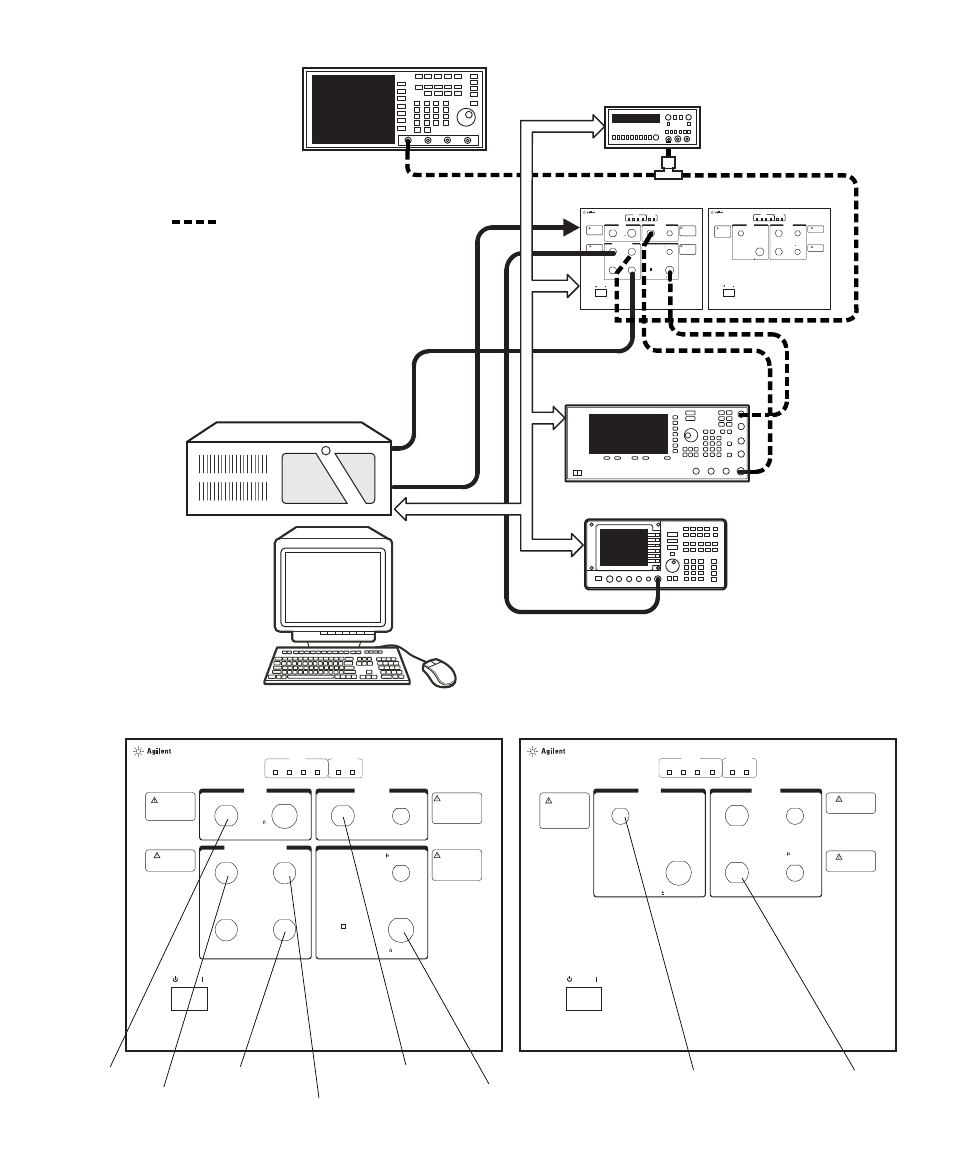User`s guide
Table Of Contents
- Title Page
- Contents
- Getting Started
- Introduction and Measurement
- Phase Noise Basics
- Expanding Your Measurement Experience
- Starting the Measurement Software
- Using the Asset Manager
- Using the Server Hardware Connections to Specify the Source
- Setting GPIB Addresses
- Testing the 8663A Internal/External 10 MHz
- Testing the 8644B Internal/External 10 MHz
- Viewing Markers
- Omitting Spurs
- Displaying the Parameter Summary
- Exporting Measurement Results
- Absolute Measurement Fundamentals
- Absolute Measurement Examples
- Residual Measurement Fundamentals
- What is Residual Noise?
- Assumptions about Residual Phase Noise Measurements
- Calibrating the Measurement
- Measurement Difficulties
- Residual Measurement Examples
- FM Discriminator Fundamentals
- FM Discriminator Measurement Examples
- AM Noise Measurement Fundamentals
- AM Noise Measurement Examples
- Baseband Noise Measurement Examples
- Evaluating Your Measurement Results
- Advanced Software Features
- Reference Graphs and Tables
- Approximate System Noise Floor vs. R Port Signal Level
- Phase Noise Floor and Region of Validity
- Phase Noise Level of Various Agilent Sources
- Increase in Measured Noise as Ref Source Approaches DUT Noise
- Approximate Sensitivity of Delay Line Discriminator
- AM Calibration
- Voltage Controlled Source Tuning Requirements
- Tune Range of VCO for Center Voltage
- Peak Tuning Range Required by Noise Level
- Phase Lock Loop Bandwidth vs. Peak Tuning Range
- Noise Floor Limits Due to Peak Tuning Range
- Tuning Characteristics of Various VCO Source Options
- 8643A Frequency Limits
- 8644B Frequency Limits
- 8664A Frequency Limits
- 8665A Frequency Limits
- 8665B Frequency Limits
- System Specifications
- System Interconnections
- PC Components Installation
- Overview
- Step 1: Uninstall the current version of Agilent Technologies IO libraries
- Step 2: Uninstall all National Instruments products.
- Step 3: Install the National Instruments VXI software.
- Step 4: Install the National Instruments VISA runtime.
- Step 5: Install software for the NI Data Acquisition Software.
- Step 6: Hardware Installation
- Step 7. Finalize National Instruments Software Installation.
- Step 8: System Interconnections
- Step 9: Install Microsoft Visual C++ 2008 Redistributable Package use default settings
- Step 10: Install the Agilent I/O Libraries
- Step 11: Install the E5500 Phase Noise Measurement software.
- Step 12: Asset Configuration
- Step 13: License Key for the Phase Noise Test Set
- Overview
- PC Digitizer Performance Verification
- Preventive Maintenance
- Service, Support, and Safety Information
- Safety and Regulatory Information
- Safety summary
- Equipment Installation
- Environmental conditions
- Before applying power
- Ground the instrument or system
- Fuses and Circuit Breakers
- Maintenance
- Safety symbols and instrument markings
- Regulatory Compliance
- Declaration of Conformity
- Compliance with German noise requirements
- Compliance with Canadian EMC requirements
- Service and Support
- Return Procedure
- Safety and Regulatory Information

System Interconnections
18
Agilent E5505A User’s Guide 405
Figure 309 E5505A system connections with test set option 201
+
23dBm
1.2-26.5GHz
+
10dBm
50kHz-1600 MHz
MAXIMUM POWER
20mA MAX
TUNE VOLTAGE
OUT OF LOCK
<
100kHz
ANALYZERANALYZER
RF ANALYZER
PHASE DET OUTPUT
MONITOR
+
15dBm MIN
50kHz- 1600MHz
+
7dBm MIN
1.2- 26.5GHz
REF INPUT
ERRACT
STATUS
SRQTLKLSN
GPIB
RMT
NOISE
0.01Hz- 100MHz
1V Pk
50
50kHz-1600 MHz
INPUT
SIGNAL
POSSIBLE
SIGNAL INPUT
<
100MHz
50
1.2-26.5GHz
+
10dBm
MAXIMUM POWER
50kHz-1600 MHz
+
23dBm
MAXIMUM POWER
+
30dBm
OUTPUT POWER
POWER
N5500A Opt 201
Test Set
1.2-26.5GHz
W SIGNAL
+
23dBm
OUTPUT POWER
POSSIBLE
+
30dBm
OUTPUT POWER
POSSIBLE
AM NOISE
OUTPUT
RF ANALYZER
2.4-25.8 GHz
W LOIF
5-1500MHz10 VOLTS MAX
CONTROL
VOLTAGE
5MHz-26.5GHz
SIGNAL
INPUT
RMT LSN TLK SRQ ERRACT
STATUSGPIB
ATTENUATOR
+
30dBm MAX WITH
+
10dBm
+
ATTEN
MAXIMUM POWER
0VDC MAX
SIGNAL INPUT
POWER
N5507A 5 MHz-26.5 GHz
Microwave Downconverter
Test set Opt. 201
Spectrum analyzer
Optional reference
signal generator
E5500 software
License key
PC-Digitizer card
Digitizer
input
To test set
rear panel
CHIRP source
Digitizer
output
Optional frequency
counter
Oscilloscope
(recommended)
GPIB
GPIB
Indicates optional cable
NOTE:
Display
Test set Opt. 201
Spectrum
analyzer
To P C
digitizer
To reference
source (optional)
To oscilloscope or
counter monitor
(optional)
DC out
tune voltage
(optional)
E5505a_opt201_conn_dia
14 Apr 04 rev 1
Downconverter
Downconverter
50 Ω load
Signal input
to be
downconverted
Downconverted
output to test set
signal input
+
23 dBm
1.2- 26.5GHz
+
10 dBm
50 kHz -1600MHz
MAXIMUM POWER
20 mA MAX
TUNE VOLTAGE
OUT OF LOCK
<
100 kHz
ANALYZERANALYZER
RF ANALYZER
PHASE DET OUTPUT
MONITOR
+
15 dBm MIN
50 kHz -1600 MHz
+
7dBm MIN
1.2 -26.5 GHz
REF INPUT
ERRACT
STATUS
SRQTLKLSN
GPIB
RMT
NOISE
0.01 Hz -100 MHz
1 V Pk
50
50 kHz- 1600MHz
INPUT
SIGNAL
POSSIBLE
SIGNAL INPUT
<
100 MHz
50
1.2- 26.5GHz
+
10 dBm
MAXIMUM POWER
50 kHz -1600MHz
+
23 dBm
MAXIMUM POWER
+
30 dBm
OUTPUT POWER
POWER
N5500A Opt 201
Test Set
1.2- 26.5GHz
W SIGNAL
+
23 dBm
OUTPUT POWER
POSSIBLE
+
30 dBm
OUTPUT POWER
POSSIBLE
AM NOISE
OUTPUT
RF ANALYZER
2.4 - 25.8GHz
W LOIF
5 -1500 MHz10 VOLTS MAX
CONTROL
VOLTAGE
5 MHz -26.5 GHz
SIGNAL
INPUT
RMT LSN TLK SRQ ERRACT
STATUSGPIB
ATTENUATOR
+
30 dBm MAX WITH
+
10 dBm
+
ATTEN
MAXIMUM POWER
0VDC MAX
SIGNAL INPUT
POWER
N5507A 5MHz-26.5GHz
Microwave Downconverter
PC










